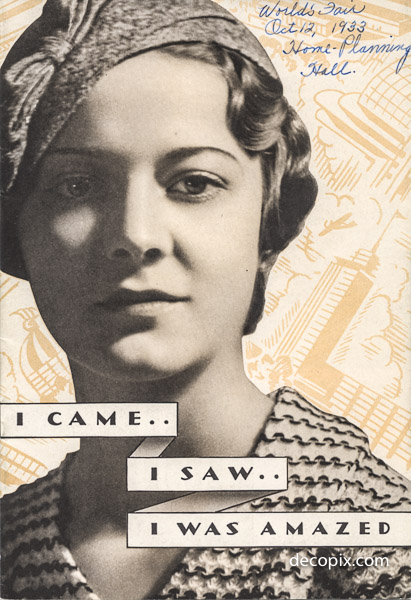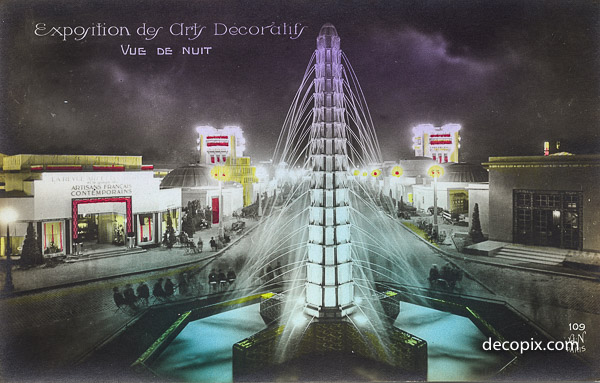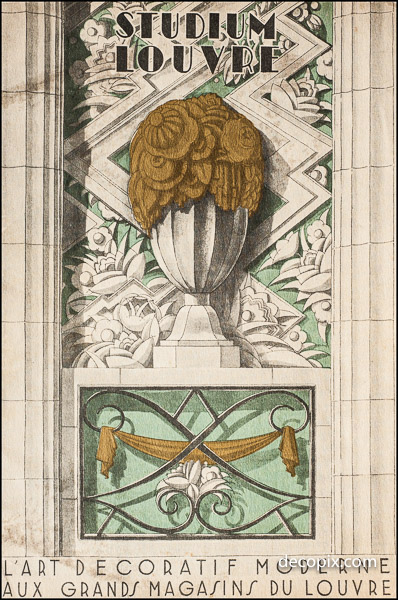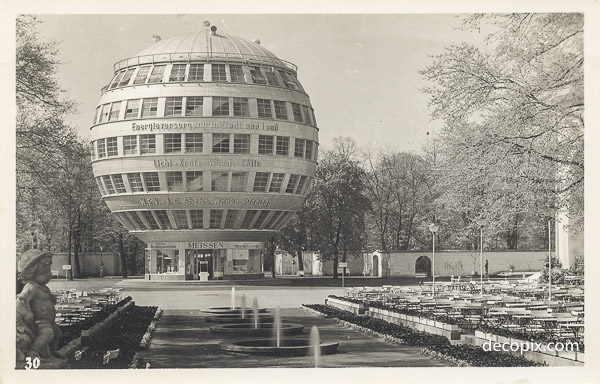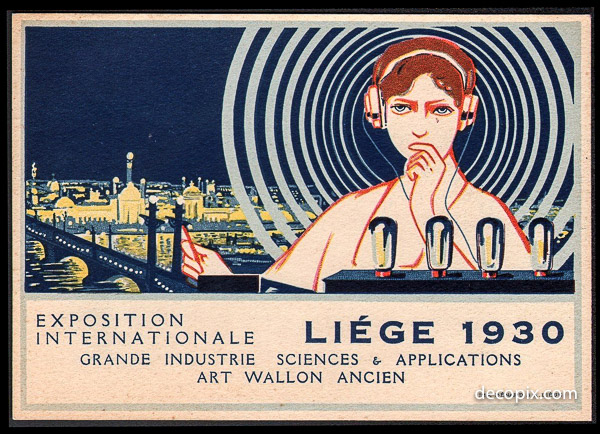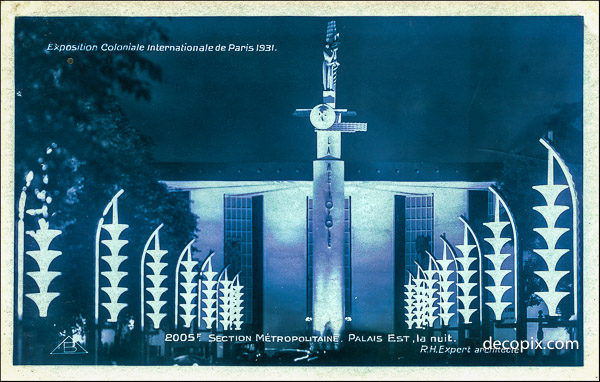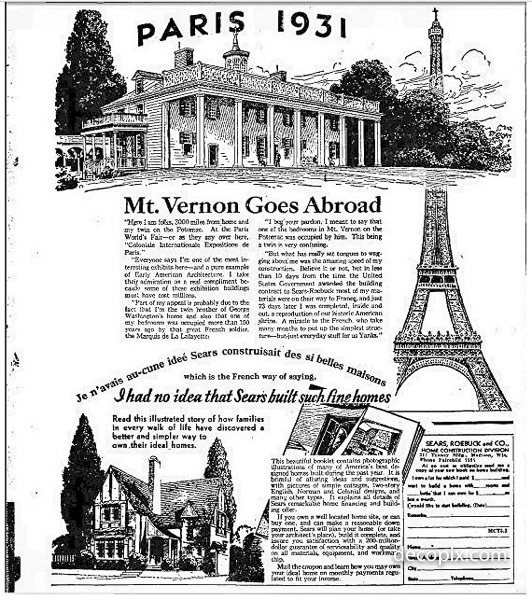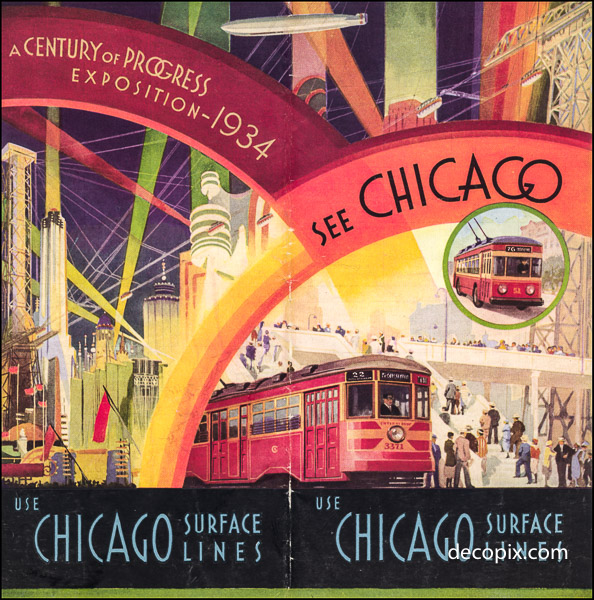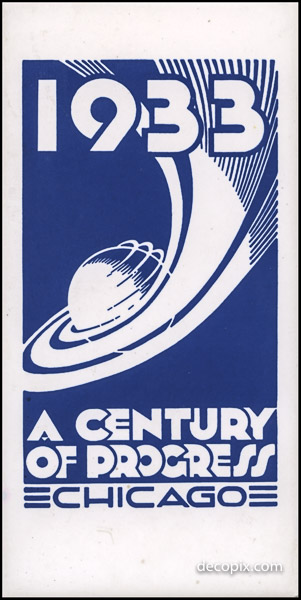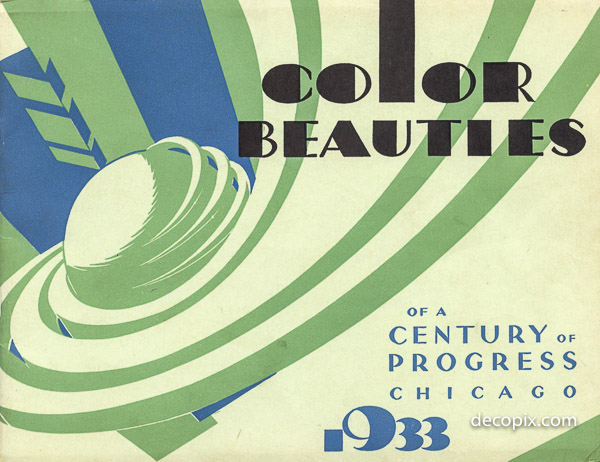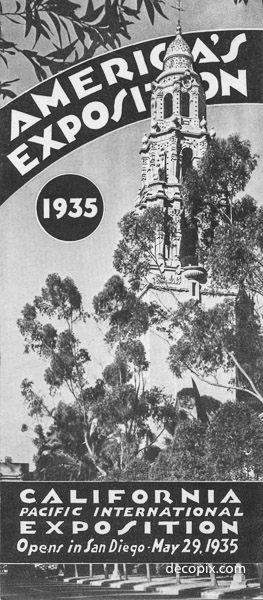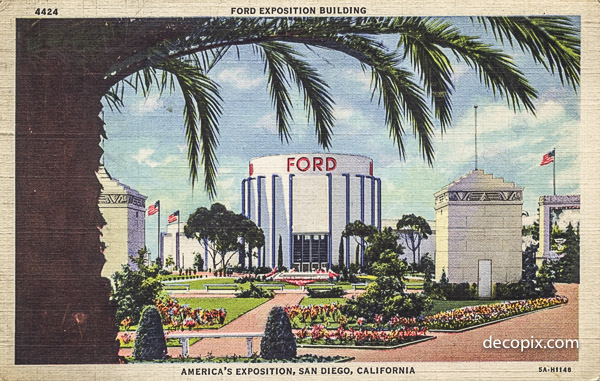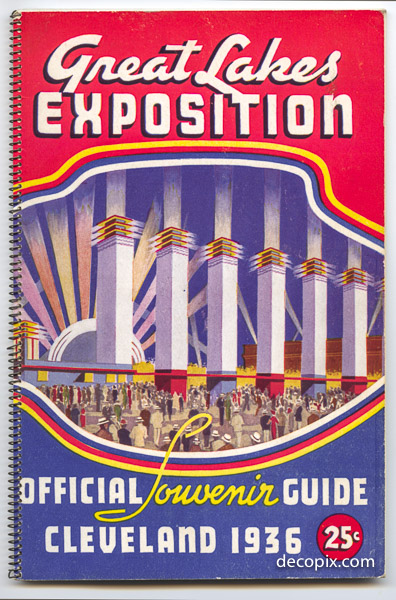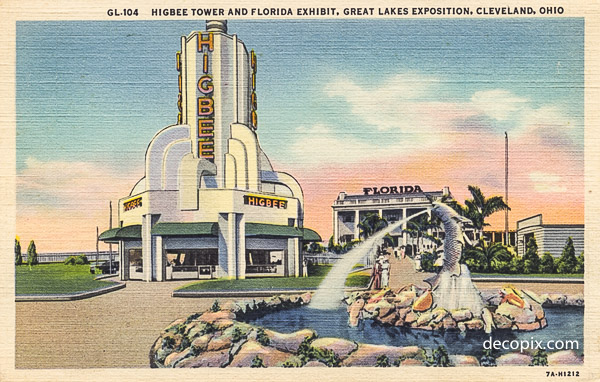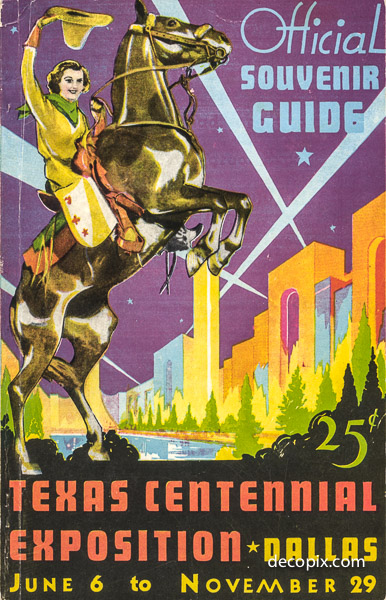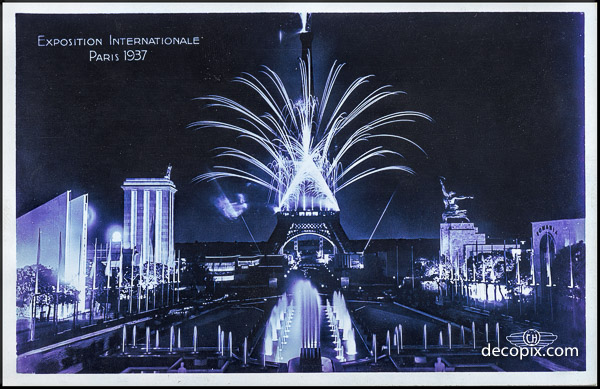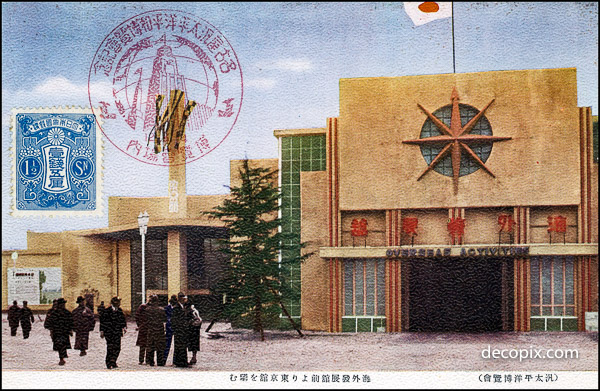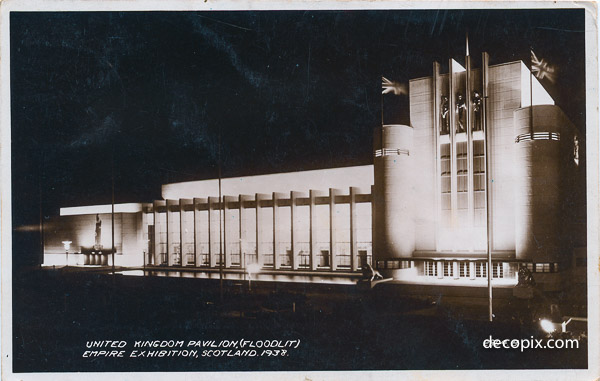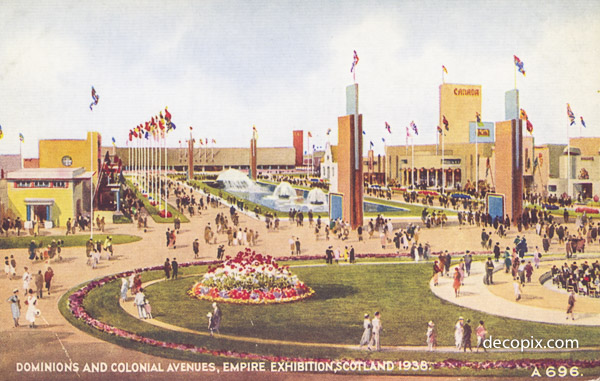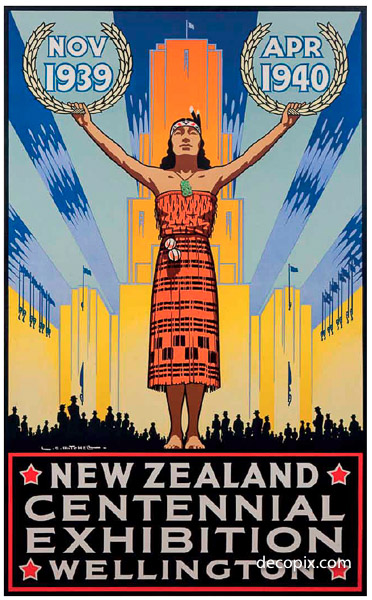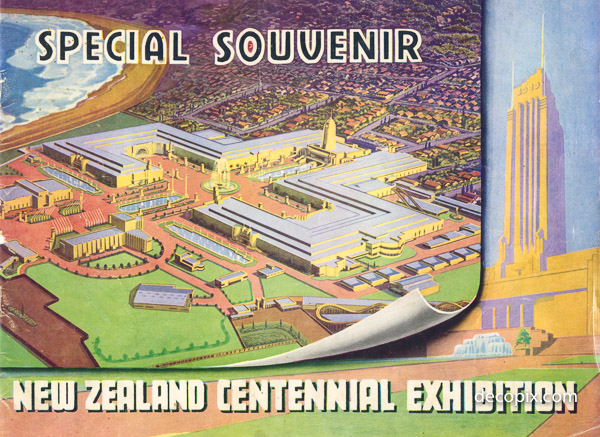1925–The ideas forming the basis of Art Deco coalesced at the Paris Exposition des Artes Decoratifs in 1925 and shortly thereafter an era of great expositions began. During the 1930s, almost every year brought an expo or Worlds Fair. Art Deco (or the later Streamline Moderne) was present at almost all of these events.
By most accounts, Paris was a great place to be in 1925. France had lost two million men in the war so the end to fighting was in itself cause for rejoicing. Much of France’s cultural life had been put on hold and it was the Exposition’s task to: promote joy in the beauty of materials, re-establish France’s cultural credentials, re-establish aesthetic thinking, and encourage business and trade. This last item, commerce, was the only theme common to all the Deco-styled fairs that would follow.
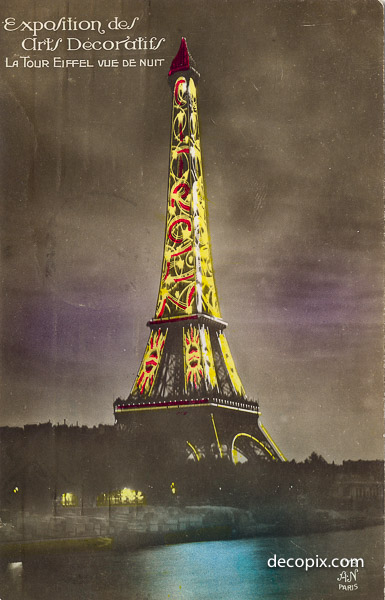
La Tour Eiffel, wraped in neon tubes spelling C-I-T-R-O-E-N.
Proposed in 1913 but delayed by World War I, the Paris 1925 exposition differed from subsequent fairs in fundamental ways. It was the only Art Deco-styled fair to be held in good economic times, Art Deco was the theme and not simply a stylistic backdrop, and–somewhat peculiarly–the Exposition des Artes Decoratifs had within its gates architectural examples that refuted aspects of it’s basic premise!
Look closely at the Paris Exposition des Artes Decoratifs. You’ll see columns, urns and numerous references to ancient architecture. True, these things were dressed up with modern ornament, but placing new ornament over old wasn’t the bold break with the past that modern design promised.
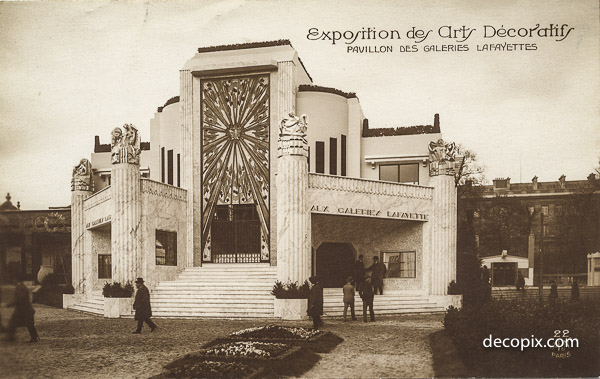
The Galeries Lafayettes pavilion with sunburst (modern or perhaps ancient Egyptian), stepped windows and old-fashioned columns
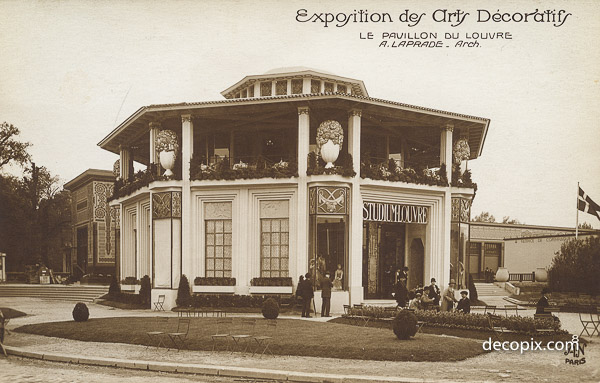
Urns, another popular feature of early Art Deco
The inclusion of historic design elements did not go entirely unnoticed. Le Corbusier’s Pavilion L’esprit Nouveau, received a hostile reception, but was exactly as advertised–a display of what was to come. Le Corbusier built an unadorned functional box that was essentially International Style.
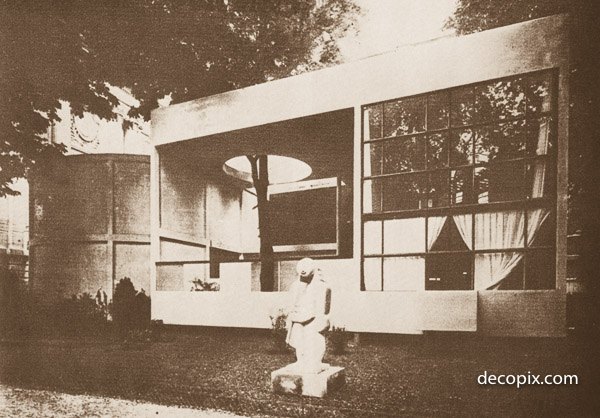
Pavilion L’espirit Nouveau
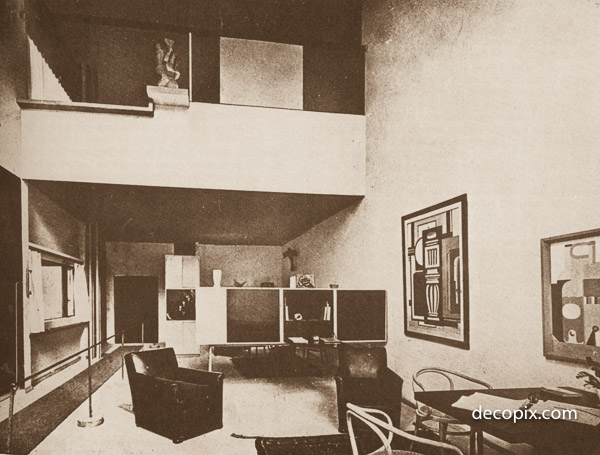
Interior, Pavilion L’espirit Nouveau
Of his pavilion, Le Corbusier said [it was] “An epic achievement untaken with no money, no land, and in the face of bitter opposition….” Similarly, Robert Mallet-Stevens‘ Information and Tourism pavilion, a clock tower with fins, could have been installed at Chicago’s Century of Progress Exposition in 1933 and fit right in. So in some ways the Paris exposition of 1925 can be thought of as both the beginning and the end of early ornate, “zigzag” (pre-streamlined) Art Deco. Or, as Groucho Marx would declare in 1930, “Hello, I must be going.”
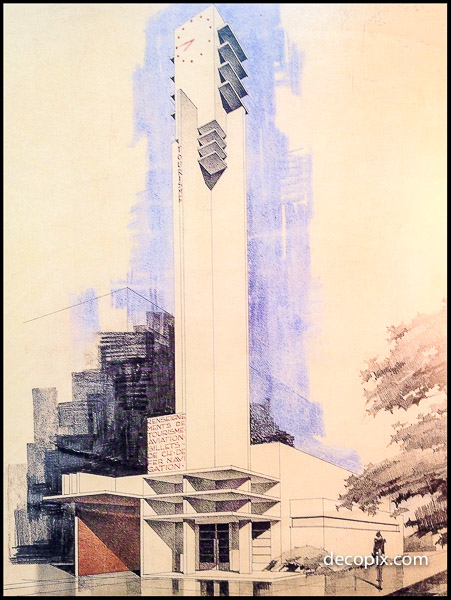
Mallet-Stevens’ Information and Tourist pavilion, Paris Expo, 1925. Compare this finned tower with Thomas Tait’s Tower of Empire at the 1938 British Empire Exposition towards the end of this post, or…
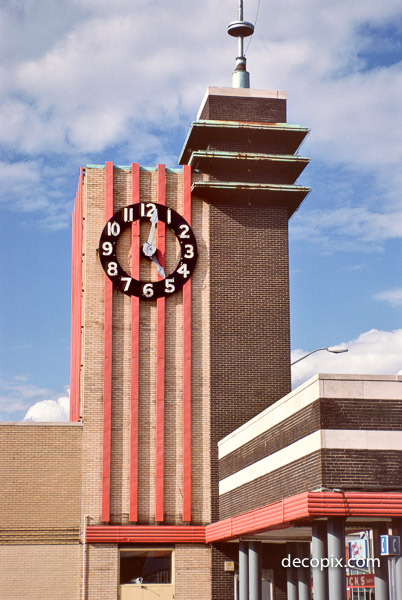
This delightful streamlined example in Kansas City.
1928– Perhaps not Art Deco but in a style all it’s own, the astonishing Kugelhaus. The 1928 Annual Show of German Work in Dresden featured the world’s first (only?) ball shaped house Built by Peter Birkenholz in just 8 weeks, weighing 280 tons with a footprint of just 110 meters. Sadly, the Kugelhaus was judged un-German by the Nazis and demolished in 1938. Having found no photos of the demolition, I picture a giant golf club….
1930– In 1930, a fair was held in Liege and Antwerp with a name long enough to stretch between the two: Exposition Internationale de la Grande Industrie, Sciences et Applications, Art Wallon Ancien. The fair’s emphasis was on science, industry, economy, agriculture and music. Architectural styles were mixed but in addition to a distinctly Art Deco gate, there was a very early example of the Streamline in the Hanseatic League’s pavilion. (The Hansa Teutonica was a confederation of merchant guilds.)
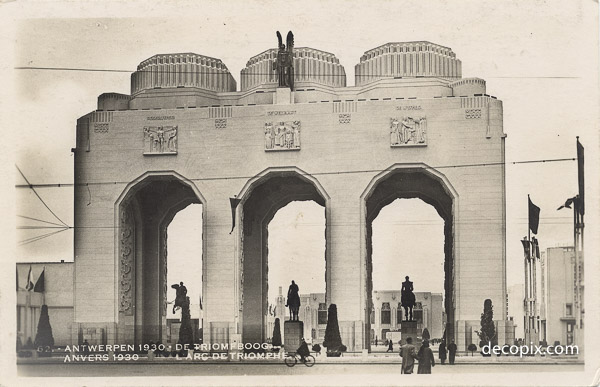
Art Deco and…
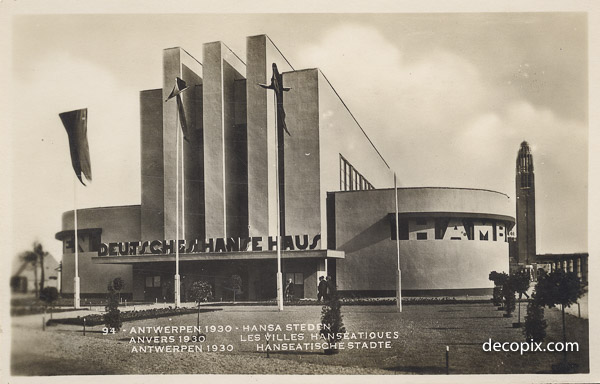
Streamline Moderne, both at the same 1930 exposition.
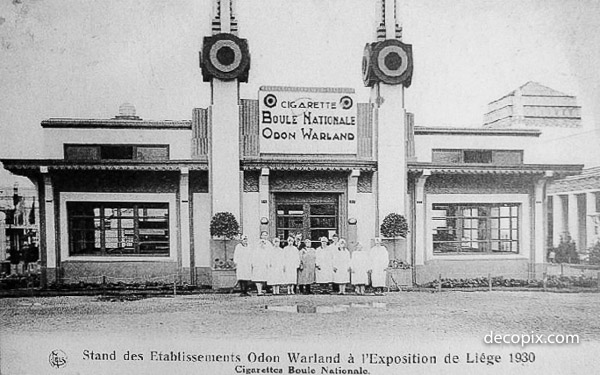
I’ve coined this Lego Deco. Some similarities to buildings at the Nagoya fair, seven years later (see below.)
1931– The 1931 Paris Exposition Coloniale Internationale was much different from it’s 1925 predecessor. According to Wikipedia, “France hoped the Exposition would paint its colonial empire in a beneficial light, showing the mutual exchange of cultures and the benefits of France’s efforts overseas.” Interestingly, in a show of France’s broad-minded nature, the Communist party was allowed an exhibit, “The Truth On Colonies” which purported to display French colonial abuses.
While the Paris 1931 exposition was devoted to foreign cultures, in pavilions showcasing indigenous architecture, Art Deco pulled things together, seen in details like fountains and lamps.
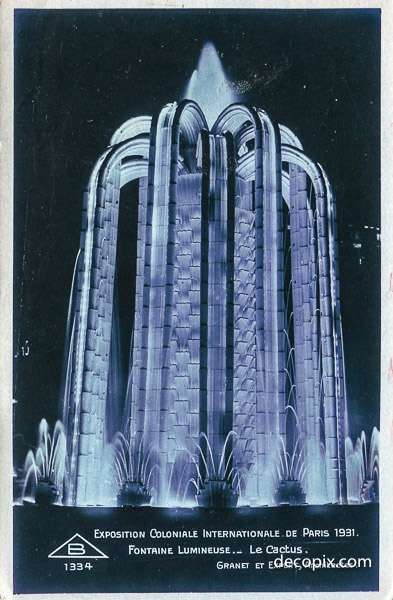
A luminescent cactus
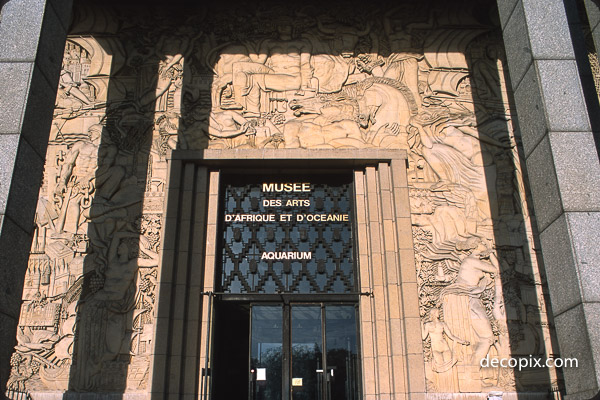
A legacy of the 1931 exposition, the Musee Des Arts D’Afrique Et D’Oceanie – a fascinating place for examples of indigenous Art Deco.
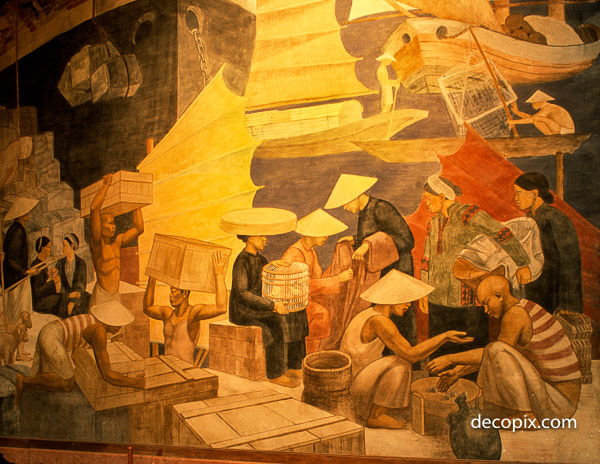
Mural, Musee Des Arts D’Afrique Et D’Oceanie
For the 1925 Paris exposition, the U.S. declined to exhibit (president Hoover believed we had nothing to offer) but for the 1931 fair, Sears received a grant from the federal government to build a replica of Mount Vernon!
1933– Arguably the most influential of the Art Deco fairs and financially the most successful, Chicago’s Century Of Progress almost didn’t happen. 1933 was close to the bottom of the Depression, and Chicago’s politicians and business leaders liked the idea but didn’t see how the money could be found. By chance, one of the fair’s promoters, Rufus C. Dawes was well connected in Washington D.C. His brother Charles was Vice President of the United States and with his influence, things started falling into place.
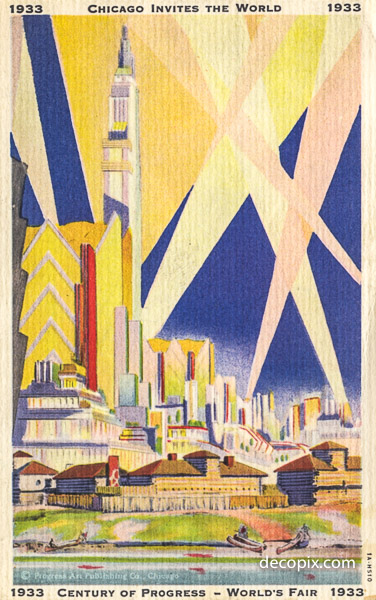
An early invitation to the Century Of Progress, showing Fort Dearborn in front of an imaginary futuristic skyline.
Anyone who’s spent a summer in Chicago can imagine how grand it must have been, spending a day at the lakeshore when air conditioning was a novelty. Many things went right for the Century Of Progress. The fair was blessed with savvy promotion, including things like advance ticket sales and season passes. It was generally well designed as well, using out-of-towners Raymond Hood and Paul Cret and locals including John Holabird (Holabird & Root had designed Chicago’s Daily News, Board of Trade, Palmolive (Playboy) and #333 North Michigan Avenue buildings, all superb examples of Art Deco.) A local architect who was not invited, Frank Lloyd Wright, had a reputation of being difficult to work with.
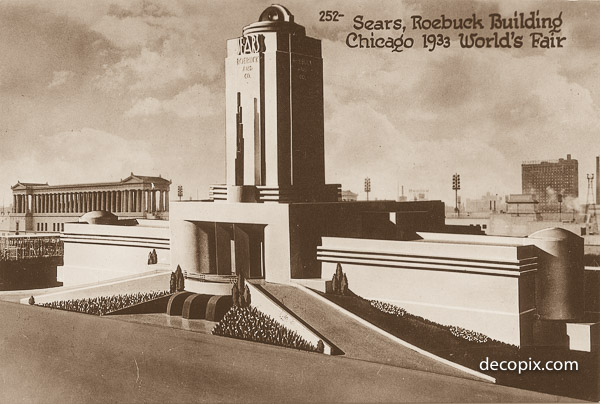
The Sears pavilion – streamlining, perfectly realized.
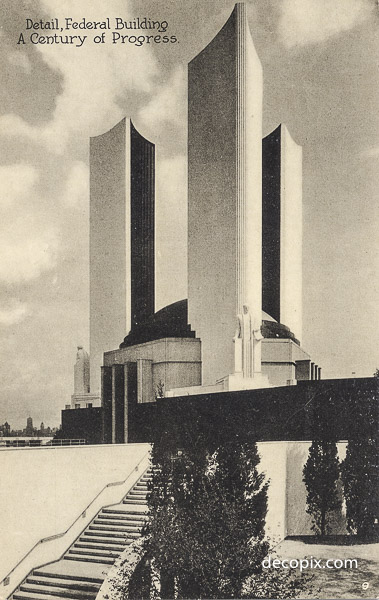
The Federal Building, with towers representing the 3 branches of government.
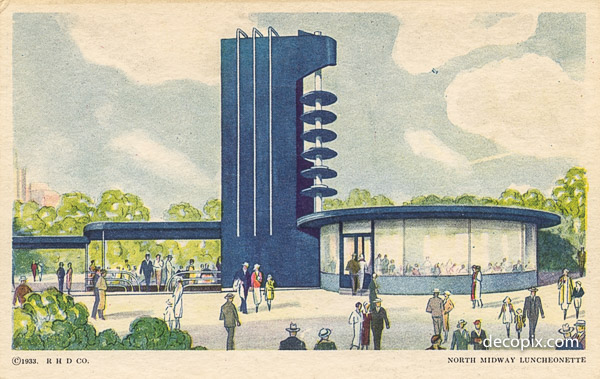
A restaurant, one of many streamlined wonders at the Century Of Progress.
The fair’s logo, a stylized rendering of the star Arcturus, was classic 1930s promotion. Arcturus was unusually close to earth. Coincidentally, “electric eye” photocells were newly introduced scientific wonders. It was decided the fair’s opening would be triggered by light from Arcturus striking a photocell. There are multiple accounts of what actually happened, or perhaps didn’t, but it still makes for a good story, told in Bill Cotter’s excellent book.
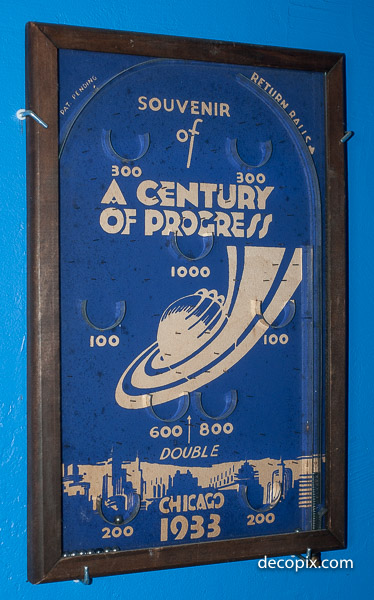
Century Of Progress pinball game
The Century of Progress closed on a bittersweet note. The fair’s final day, October 31, 1934 was Halloween. Perhaps there was something in the air. Crowds took to looting and fighting with more than 1000 people injured.
In the end, despite lower than expected attendance, the Century of Progress turned a small profit and it’s streamlining paved the way for the New York World’s Fair, still five years away.
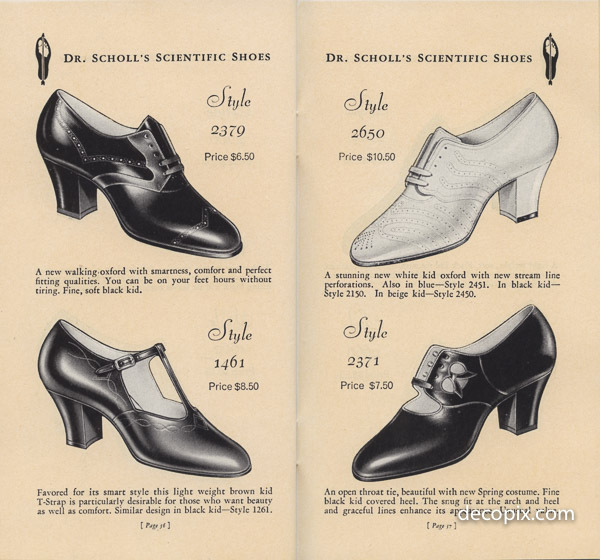
I couldn’t resist including this. From the Dr. Scholl’s pavilion at A Century Of Progress, a brochure with shoe recommendations for fairgoers.
1935– Out west, 1935-36 California Pacific International Exposition in San Diego was a stylistic hodgepodge. Much of the beautiful architecture from the Panama-California Exposition of 1915-17 had been preserved so the task at hand was more of a makeover.
Putting Art Deco in the midst of Spanish Colonial architecture might seem odd–and it was, frankly–but it did show Art Deco’s adaptability and chameleon-like nature.
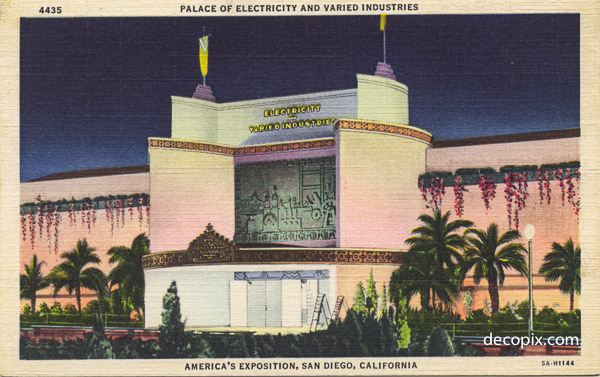
Both the Palace Of Electricity and the Ford pavilion abvove, still survive.
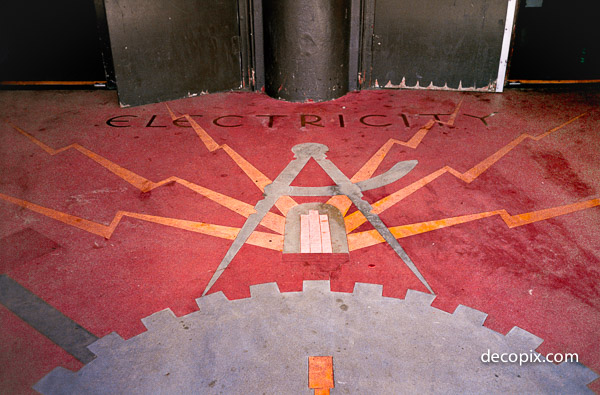
Terrazzo floor, Palace Of Electricity
1935 also saw the Brussels International Exposition whose principal architect, Joseph van Neck designed several Art Deco buildings. The centerpiece, the Palais du Centennaire, still stands.
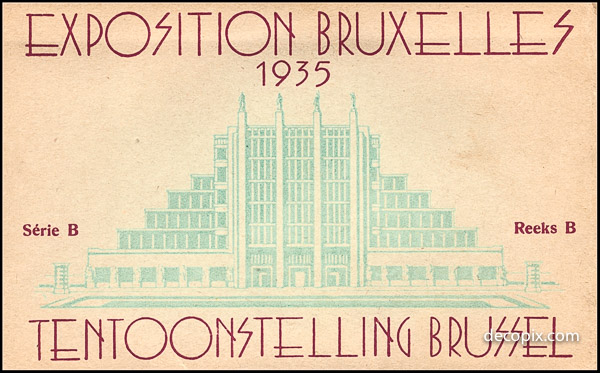
The Palais du Centennaire pictured here still stands.
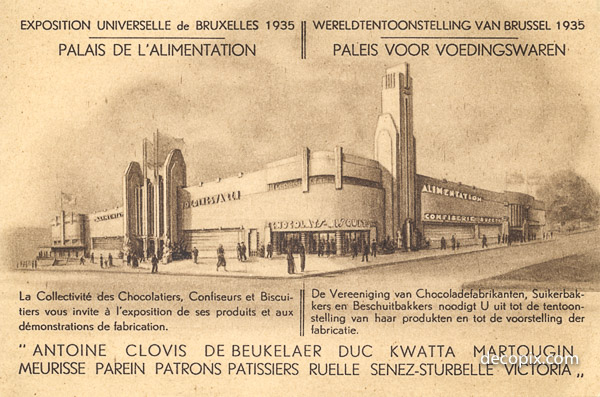
A treat both inside and out, the Collectivite des Chocolatiers, Brussells 1935.
1936– There were two American fairs in 1936. The Great Lakes Exposition in Cleveland celebrated the centennial of Cleveland’s incorporation as a city. A modest affair, the Great Lakes Expo featured displays from local businesses including White Motor, Standard Oil, Firestone, Goodyear, Sherman Williams, General Electric. Also present was local retailer Higbee’s, whose Art Deco department store still stands although Higbee’s is long gone.
Meanwhile in Texas, 1936 was the 100th anniversary of independence from Mexico. The Texas Centennial, held in Dallas was a mostly Art Deco-styled event with wonderful Texas influences such as Art Deco cactus motifs and of course the great star of Texas.
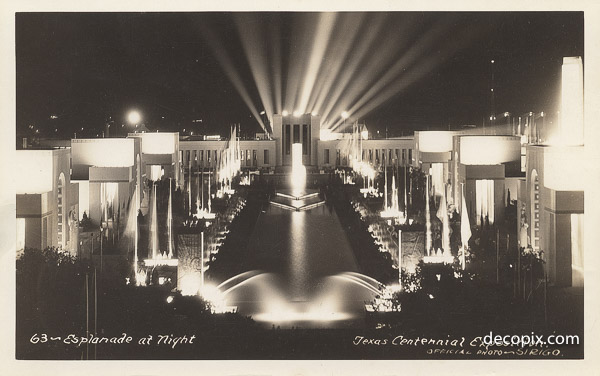
All intact, except for the light show.
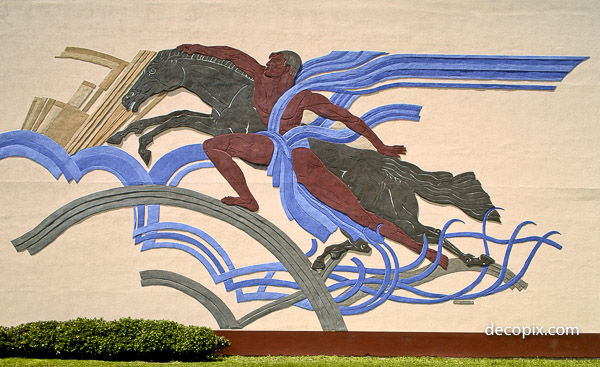
A fantastic relief by Pierre Bourdelle who also worked at the Paris 1925 expostion.
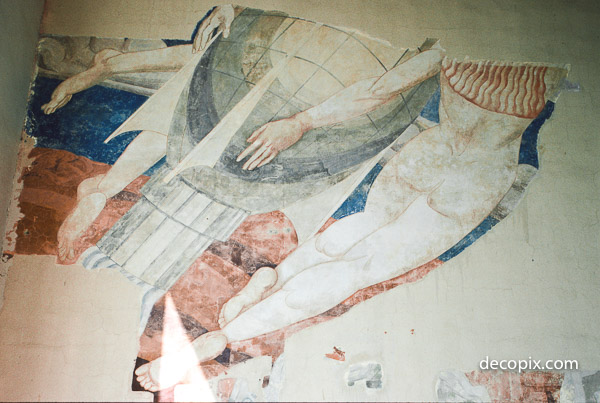
It took quite awhile but Fair Park has done an awesome job restoring the murals of Carlo Ciampaglia.
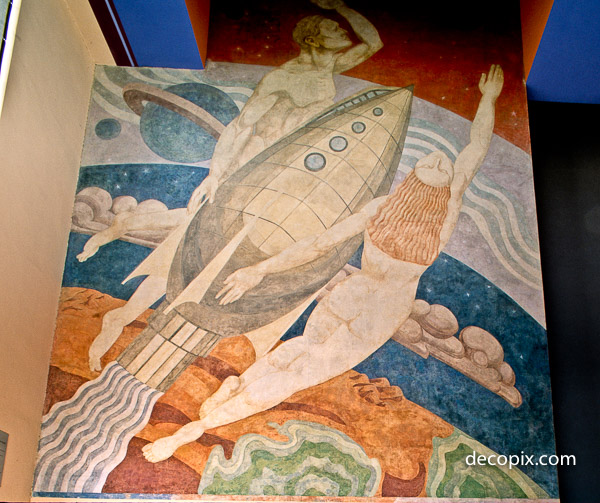
Everbody’s favorite (by un-scientific poll) Carlo Ciampaglia’s Future Transportation. If you can’t find it, ask to see the Rocketship mural–they’ll know.
What makes the Texas Centennial stand tall alongside other 1930s expositions is that most of it remains today. The Centennial fairgrounds are open year round and still host the Texas State Fair. For those of us who didn’t get to go to any 1930’s fair, the Texas State Fairgrounds are probably as close as we will ever come. The Texas Centennial went into second year, re-branded as the Greater Texas & Pan-American Exposition.
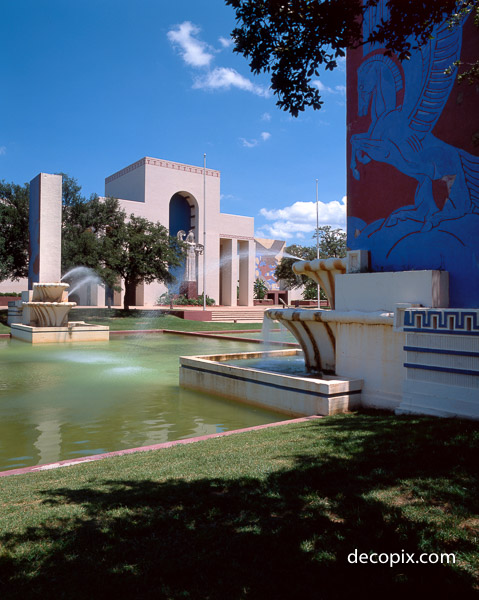
The fairgrounds today
1937– In 1937, Paris hosted the Exposition Internationale des Arts et Techniques dans la Vie Moderne. The 1937 event was an officially sanctioned worlds fair with a focus on technology. Individual pavilions were devoted to cinema, radio, light, railroads, flight, refrigeration and printing.
There was art as well, and some great works like Raoul Dufy’s gorgeous tribute to light, Le Fee Electricite (The Electricity Fairy). Picasso’s Guernica made its first appearance. But the fair is remembered mostly for the simmering tensions between the countries in attendance. If there was any doubt, the Russian and German pavilions were sited facing each other across the lagoon.
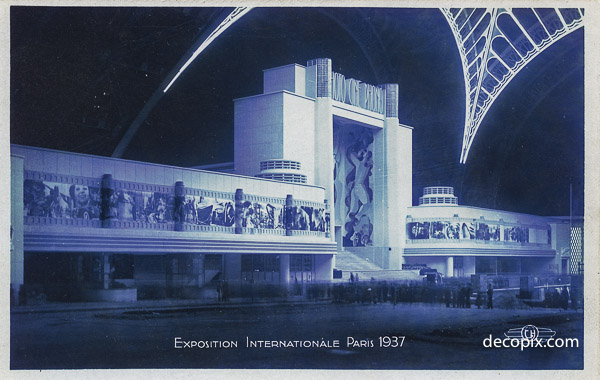
That’s the Eiffel Tower in the top right corner.
1937 also brought the unfortunately named Pan-Pacific Peace Exhibition in Nagoya. (There were beautiful Art Deco posters for the fair, featuring doves.)
Japan, and Nagoya in particular hosted many expos, usually government sponsored. Here’s a fascinating image from the Nagoya Exhibition Okinawa Festival, date unknown:
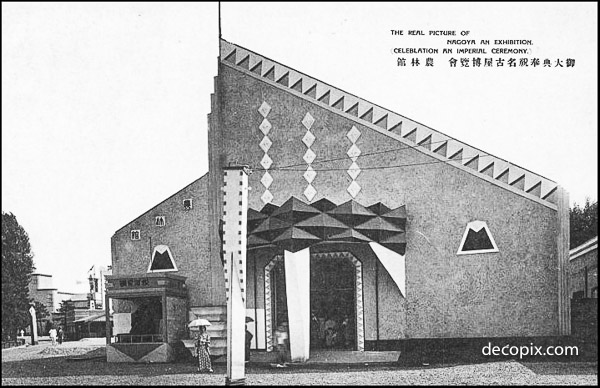
Agriculture & Forrestry Hall, Nagoya Exhibition Okinawa Festival, date unknown.
1938– Times were tough in Glasgow in 1938. Once the “Workshop of the Empire”, Glasgow’s industrial sectors–ships, engines, locomotives, steel and textiles were struggling. It would take the war to put people back to work, but in 1938, the British Empire Exhibition was held in an attempt to get the economic ball rolling.
The exposition’s Art Deco pedigree was the result of it’s architect, Thomas Tait. Not well known outside the U.K., Tait was responsible for a wide variety of buildings, including Art Deco and streamlined types. Tait designed the London Daily Telegraph’s offices, residences in London’s lovely St. John’s Wood and the homes at Silver End (a modernistic village created by Francis Crittall of Crittall Windows fame.) Tait also designed the pylons for the Sydney Harbour Bridge so if you’re in Australia, you can climb on his work.
The centerpiece of the Glasgow 1938 exhibition was the Tower Of Empire, popularly known as Tait’s Tower. It looks impressive in photos and must have been even more so in person, with it’s three observation balconies, each accommodating 200 visitors.
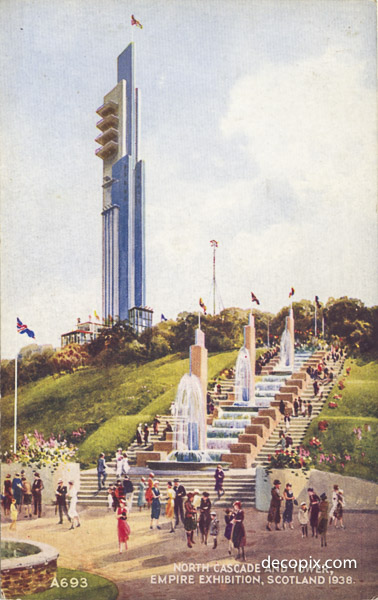
The Tower Of Empire, Glasgow 1938.
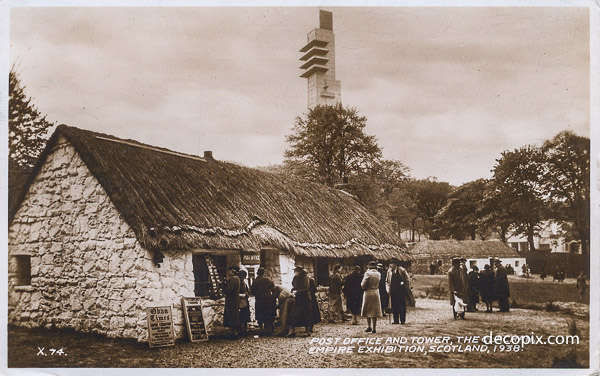
An interesting juxtaposition, the exhibition’s post office with Tait’s tower in the background.
1939– The New York Worlds Fair and San Francisco Golden Gate Exposition of 1939-40 were the last of the great Art Deco expositions. Since this site leans toward lesser-known aspects of Art Deco, I direct the reader to the many sites and books dedicated to New York’s fabulous World Of Tomorrow and San Francisco’s Treasure Island. Both fairs closed before the attack on Pearl Harbor, but accounts from the time make clear that visitors to the New York fair knew their utopian world would have to wait, at least until the end of another war.
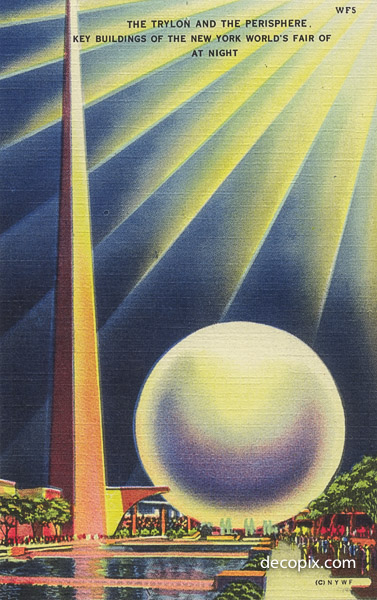
The Trylon, representing the finite and the Perisphere, the infinate. Or, in the age of the skyscraper, was it the other way around?
The closing of New Zealand Centennial of 1939-40 preceded the end of New York’s fair, but in the interest of ending on a peaceful note–and allowing for the seasons being reversed–I’ve saved it for last.
New Zealand’s centennial celebrated the 100th anniversary of the signing of the Treaty of Waitangi which, if I have it correctly, was an agreement between the Maori people and the British, providing protection from aggression by the French (see Paris Expo 1931.) This is an oversimplification, and since the Decopix fan base includes readers from New Zealand, I expect to receive clarification and will update as needed.
Photos of the New Zealand Centennial show considerable similarities to the Texas Centennial. In fact a big difference appears to be that there weren’t many people in New Zealand 1939. Both events were very much in the Art Deco/streamline style.
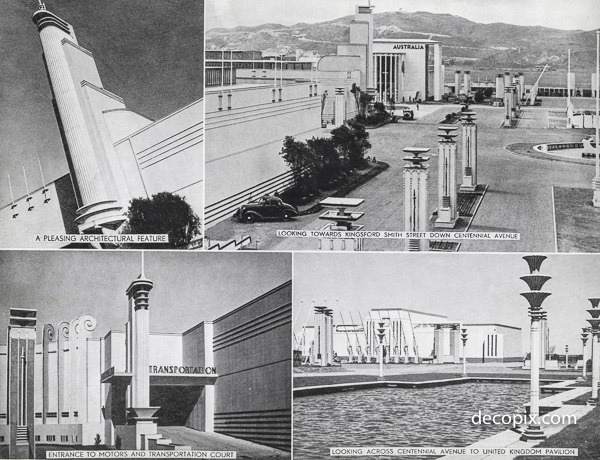
Some views of the New Zealand Centennial Exposition.
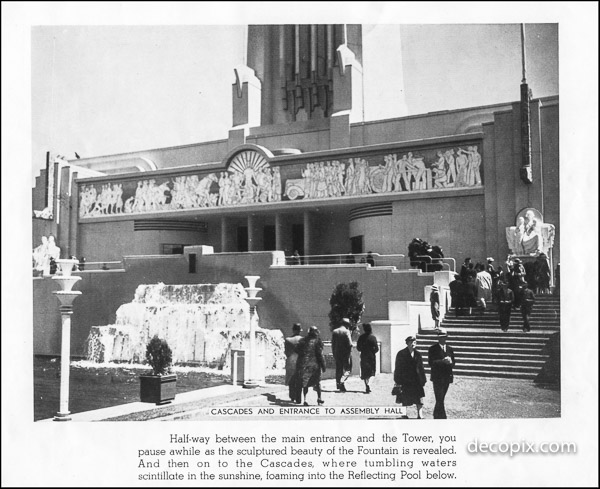
The base of the assembly hall and tower, centerpiece of the New Zealand Centennial Expo.
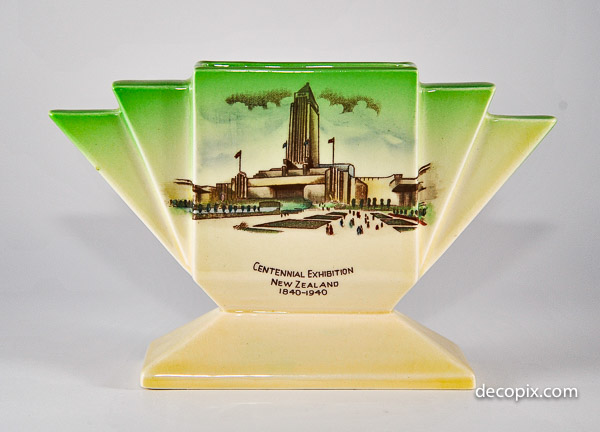
A Carltonware souvenir vase, made in England.
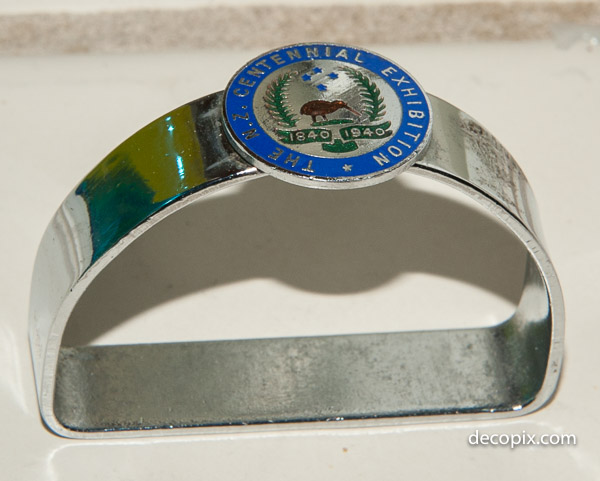
A New Zealand Centennial napkin ring with a Kiwi bird, of course.
Another interesting bit of New Zealand exposition history is that the Centennial’s official photographer was a woman, Eileen Deste. I don’t know nearly as much as I would like about Ms. Deste, but how she made her way from photographing jewelry for Cartier in London to flying over the New Zealand Centennial is a story for another post.
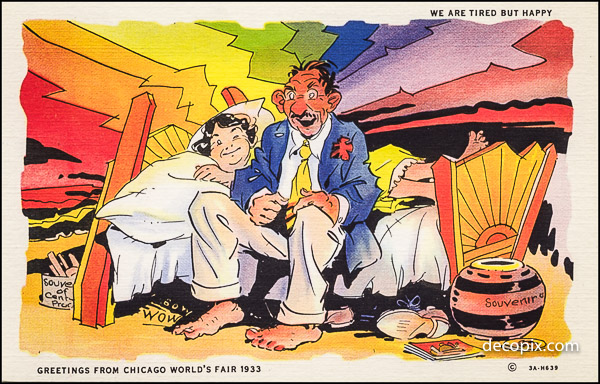
A long day at the fair draws to a close.
